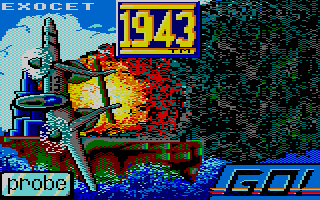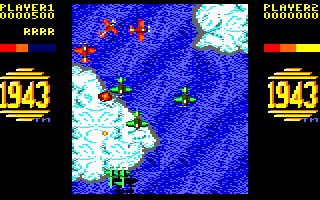1943: The Battle of Midway for Amstrad CPC
Amstrad CPCGame controls in browser
Show Controller & SystemClick on play Amstrad CPC game now button first to start emulator and load the game. Controls:
1943: The Battle of Midway
Online version of 1943: The Battle of Midway for Amstrad CPC. 1943: The Battle of Midway is a 1987 shoot 'em up arcade game developed and published by Capcom. It was the first followup to Capcom's earlier 1942. The game's name is a reference to the Battle of Midway, which in actuality happened in June of 1942. The game is set in the Pacific theater of World War II, off the coast of the Midway Atoll. The goal is to attack the Japanese air fleet that bombed the American aircraft carrier, pursue all Japanese air and sea forces, fly through the 16 stages of play, and make their way to the Japanese battleship Yamato and destroy her. 11 of these stages consist of an air-to-sea battle (with a huge battleship or an aircraft carrier as the stage boss), while 5 stages consist of an all-aerial battle against a squadron of Japanese bombers with a mother bomber at the end...
Game details
Other platforms online 3
You can play 1943: The Battle of Midway online also in a versions for67%
rating (4 users voted)
Covers - Box Art
Amstrad CPC Computers
Online emulated version of 1943: The Battle of Midway was originally developed for the Amstrad CPC (Colour Personal Computer), a series of 8-bit home computers produced by Amstrad between 1984 and 1990. It was designed to compete in the mid-1980s home computer market dominated by the Commodore 64 and the Sinclair ZX Spectrum in Europe. The series spawned a total of six distinct models: The CPC464, CPC664, and CPC6128 were highly successful competitors in the European home computer market. The later 464plus and 6128plus, intended to prolong the system's lifecycle with hardware updates, were considerably less successful, as was the attempt to repackage the plus hardware into a game console as the GX4000.
The CPC models' hardware is based on the Zilog Z80A CPU, complemented with either 64 or 128 KB of RAM. Their computer-in-a-keyboard design prominently features
an integrated storage device, either a compact cassette deck or 3 inch floppy disk drive. The main units were only sold bundled with either a colour,
green-screen or monochrome monitor that doubles as the main unit's power supply. Three built-in display resolutions are available:
160×200 pixels with 16 colours, 320×200 pixels with 4 colours, and 640×200 pixels with 2 colours.
The CPC uses the General Instrument AY-3-8912 sound chip, providing three channels, each configurable to generate square waves, white noise or both.
Additionally, a wide range of first and third-party hardware extensions such as external disk drives, printers, and memory extensions, was available.




